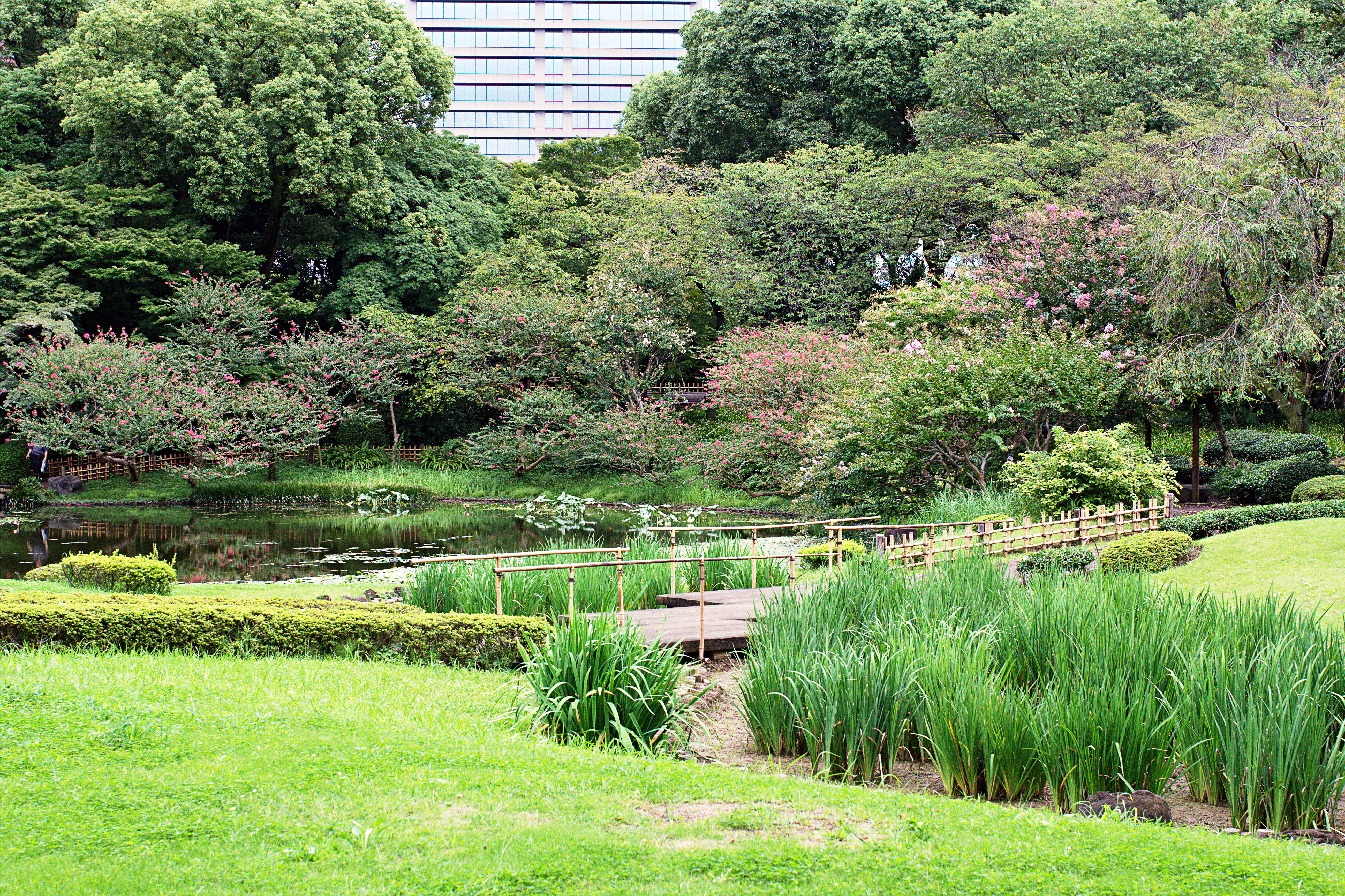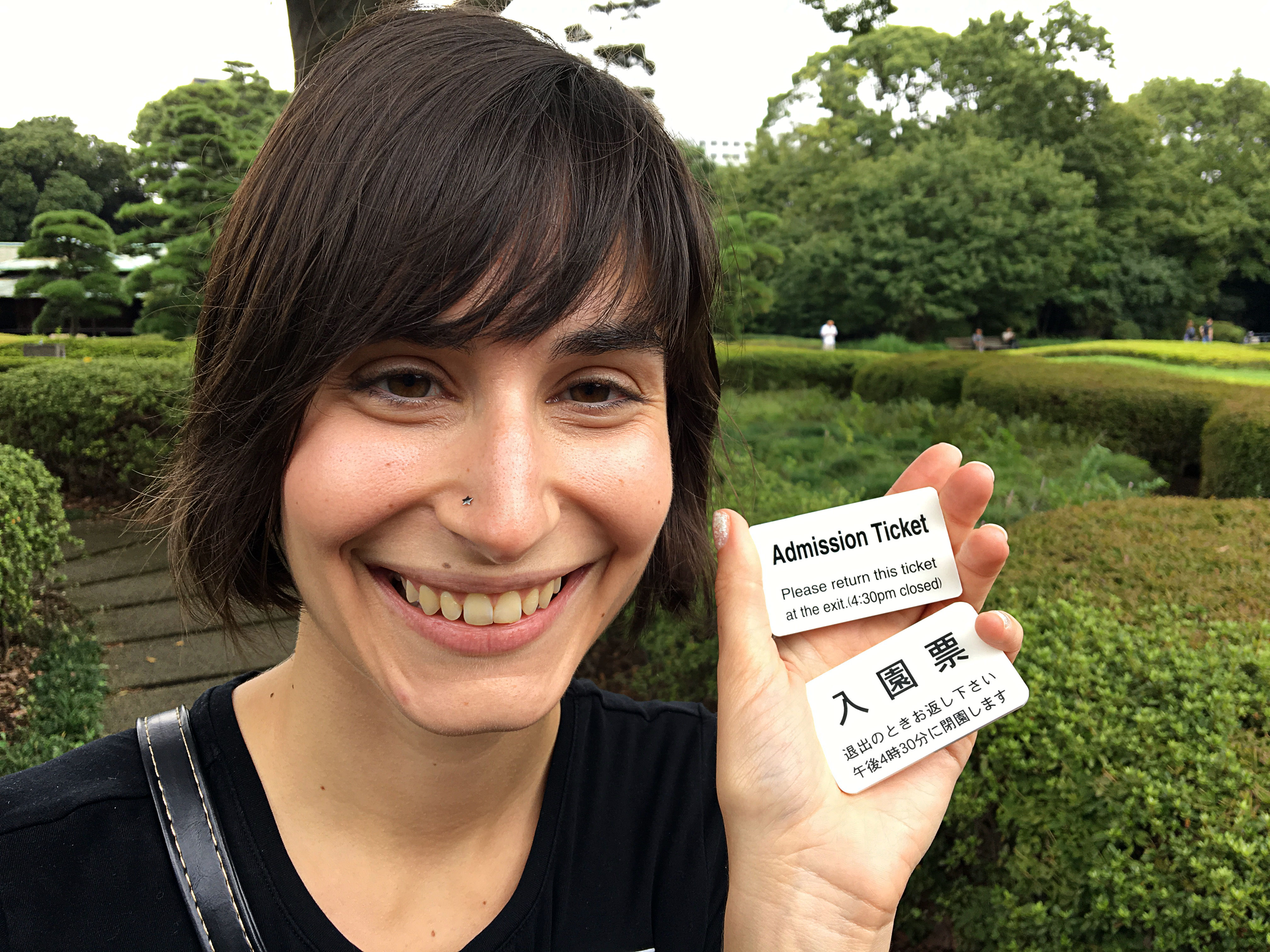Picking up where we left off in the last post, we made our way to the Imperial Palace East Gardens. The entire grounds here cover 250 acres and are home to Japan’s Emperor and Empress. The gardens are situated in downtown Tokyo, so again, you have a beautiful serene area and quite the step out of time just settling right in the middle of the city. First, walking into the gardens you cross a bridge surrounded by a large moat.

Once inside and past the walls, is an area with a 90 degree turn and then block by yet another wall with giant wooden and iron reinforced doors. The 90 degree turn we were told was a strategic placement that would cause any invaders to be forced to slow down to negotiate the turn, thus providing a bottle neck by which the defensive soldiers could lay waste to the enemy trapped between the double gates and their own slowed pace.
After passing the second gate, you walk down long, wide roads that expand over gardens. Situated off of these roads are old structures that housed powerful dignitaries as well as served as tea houses for performing tea ceremonies, an old, japanese tradition.



We also decided, before we left, to take some nerdy pictures with our admission tickets. These tickets were a thick piece of plastic and you given one on arrival and it was to be returned to the ticket booth when exiting. The gardens did not have an entry fee.


After the tour of the gardens, we exited the grounds and were once again reminded we were still deep in the heart of Tokyo. Tokyo’s modernization and just the passage of time have spared the imperial grounds, but steps itself right up to its borders. Here’s the view walking out of the Imperial Gardens:

I’d like to point out here that in the picture above you may notice something out of place. Carefully look and you will clearly see the cars are driving on the other side of the road than in the states. If you’ve never experience this firsthand let me tell you it is very strange. Whenever we go to cross a street we automatically look to our left first then right, but in Japan you have to look right first then left, as the first lane you would step into traffic would be coming from the right. Just a little while ago we were walking back to our hotel and I watched a car pass from our right to left. As soon as we reached the street, even though about 5 seconds elapsed and I saw the car, I still looked left then right. It’s very much ingrained in us from living with it for so long in the US.
We boarded the bus again and were taken to a restaurant for lunch. There we were served a traditional japanese lunch, which had a ton of food and quite a good variety. It had various tempuras and the shrimp tempura was amazing. We also had yakitori with rice of course, tofu, salad, miso soup, a strange swiss-cheese looking vegetable in a peanut sauce and then for dessert we had mochi with red bean paste, which was most excellent. We have been on the hunt for more mochi since. Here’s a picture of the meal:

When we finished our lunch we headed back to the tour group’s rally point and on the way we took these pictures to show a common practice in Japan. The following picture shows a window display for the various meals you can get at a restaurant. Sometimes it’s as simple as a menu with pictures while other times there will be an elaborate fake food display. The food depicted below is all plastic and rubber. This allows passersby to see what the restaurant has to offer as well as helping non-japanese speaking patrons to identify the meal they’d like. Each display usually has japanese names accompanied by the meal’s name in english or a number.

Our next stop was Hama-Rikyu Gardens. These gardens were created during the Edo period of Japan which spanned from 1603 to 1868 and was the period of the Daimyos, or lords of feudal Japan. The first picture here shows a black pine that is 300 years old and was planted by the sixth shogun Ienobu, who had repaired the gardens in the early 1700s.

Here are a few more pictures of the gardens:


This next picture shows a structure built into the ground that was essentially an old hunting blind. It faces a pond that was created to bring ducks and other waterfowl in for hunting. It was quite a production according the sign explaining the structure. The sign mentioned that the pond was created and domesticated ducks were brought in to trick the wild waterfowl to think the pond was safe. Then hunters and their aids would clap wooden sticks, which apparently attracted more game. Then, when the time was right, the hunter would make his move.

After the gardens, we took a boat ride down the Sumida river, however the boat was covered and the pictures weren’t so hot from shooting through the glass windows, which had plenty of glares in the way of the shots. We took the boat to Asakusa to reach our destination of the buddhist, Senso-ji Temple. The temple itself is impeccable and very beautiful. You first enter under and archway that leads into Nakamise shopping street, which is packed with people due to the streets souvenirs and more traditional japanese arts and other keepsakes.
When we got off of the boat we were greeted by a ninja… I know I know how cliche, but let’s be honest no trip to Japan is complete without one. His name was Hiroki, and he’s an actor in Japan. When we met him the first time he was a ninja and when we saw him later in the evening he was dressed as a Samurai complete with a top knot. He was really funny and said we will never forget him and that he will be coming to America one day to get into acting in the states. Here he is welcoming us to Asakusa:
And here’s the entrance to the temple grounds below:

The following picture is the main temple at Senso-ji:

The smoke you see in the above picture is part of a ritual where the patrons pull the smoke over top of themselves as if washing themselves with water, but with smoke. It seems to be some sort of cleansing before going into the temple itself. At the top of the stairs right before entering, people pray in much the same manner as they did at the Meiji shrine. After, the smoke cleansing and an initial prayer at the alter to the entrance of the temple, there resides a golden alter inside the temple. Here it is:

This was our last stop before being dropped off in Akihabara, the electronics district. We opted to get off here rather than the tour bus taking us back as that would’ve taken us an hour we were told as opposed to the quick 20 minute train back to Shinjuku, where our hotel is.
Before boarding the train, I snapped a quick pano of one of the streets in Akihabara. You can see a Sega building across the street. It’s red.

And finally, that brings us to the end of day 2. Next up, our first free day to explore Tokyo on our own.
Return to top


Wow wow wow that’s all I can say. WOW so interesting and amazing. So much history and modernization all together. Your lunch looked delicious and the presentation was was awesome. Can’t wait to read day 3 now.
Love you both
These pics are amazing. I’m in love with the ninja!
Lol, I had a feeling you would like the ninja haha. He was a cool guy, pretty funny too lol.